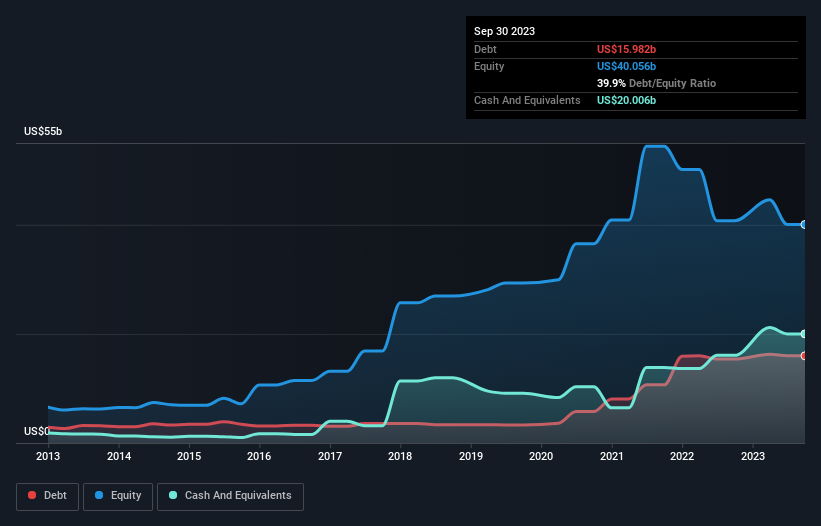Is Naspers (JSE:NPN) Using Too Much Debt?
David Iben put it well when he said, 'Volatility is not a risk we care about. What we care about is avoiding the permanent loss of capital.' So it might be obvious that you need to consider debt, when you think about how risky any given stock is, because too much debt can sink a company. We note that Naspers Limited (JSE:NPN) does have debt on its balance sheet. But the real question is whether this debt is making the company risky.
What Risk Does Debt Bring?
Debt assists a business until the business has trouble paying it off, either with new capital or with free cash flow. If things get really bad, the lenders can take control of the business. While that is not too common, we often do see indebted companies permanently diluting shareholders because lenders force them to raise capital at a distressed price. Of course, the upside of debt is that it often represents cheap capital, especially when it replaces dilution in a company with the ability to reinvest at high rates of return. The first thing to do when considering how much debt a business uses is to look at its cash and debt together.
Check out our latest analysis for Naspers
What Is Naspers's Net Debt?
As you can see below, Naspers had US$16.0b of debt, at September 2023, which is about the same as the year before. You can click the chart for greater detail. But on the other hand it also has US$20.0b in cash, leading to a US$4.02b net cash position.

How Strong Is Naspers' Balance Sheet?
We can see from the most recent balance sheet that Naspers had liabilities of US$4.46b falling due within a year, and liabilities of US$16.0b due beyond that. Offsetting this, it had US$20.0b in cash and US$1.42b in receivables that were due within 12 months. So it actually has US$976.0m more liquid assets than total liabilities.
This surplus suggests that Naspers has a conservative balance sheet, and could probably eliminate its debt without much difficulty. Simply put, the fact that Naspers has more cash than debt is arguably a good indication that it can manage its debt safely. The balance sheet is clearly the area to focus on when you are analysing debt. But it is future earnings, more than anything, that will determine Naspers's ability to maintain a healthy balance sheet going forward. So if you're focused on the future you can check out this free report showing analyst profit forecasts.
In the last year Naspers wasn't profitable at an EBIT level, but managed to grow its revenue by 21%, to US$7.0b. Shareholders probably have their fingers crossed that it can grow its way to profits.
So How Risky Is Naspers?
While Naspers lost money on an earnings before interest and tax (EBIT) level, it actually booked a paper profit of US$4.4b. So taking that on face value, and considering the cash, we don't think its very risky in the near term. Keeping in mind its 21% revenue growth over the last year, we think there's a decent chance the company is on track. We'd see further strong growth as an optimistic indication. The balance sheet is clearly the area to focus on when you are analysing debt. However, not all investment risk resides within the balance sheet - far from it. For example Naspers has 2 warning signs (and 1 which doesn't sit too well with us) we think you should know about.
If, after all that, you're more interested in a fast growing company with a rock-solid balance sheet, then check out our list of net cash growth stocks without delay.
Valuation is complex, but we're here to simplify it.
Discover if Naspers might be undervalued or overvalued with our detailed analysis, featuring fair value estimates, potential risks, dividends, insider trades, and its financial condition.
Access Free AnalysisHave feedback on this article? Concerned about the content? Get in touch with us directly. Alternatively, email editorial-team (at) simplywallst.com.
This article by Simply Wall St is general in nature. We provide commentary based on historical data and analyst forecasts only using an unbiased methodology and our articles are not intended to be financial advice. It does not constitute a recommendation to buy or sell any stock, and does not take account of your objectives, or your financial situation. We aim to bring you long-term focused analysis driven by fundamental data. Note that our analysis may not factor in the latest price-sensitive company announcements or qualitative material. Simply Wall St has no position in any stocks mentioned.
About JSE:NPN
Naspers
Operates as a consumer internet company in Africa, Asia, Europe, and internationally.
Good value with proven track record.
Similar Companies
Market Insights
Community Narratives


